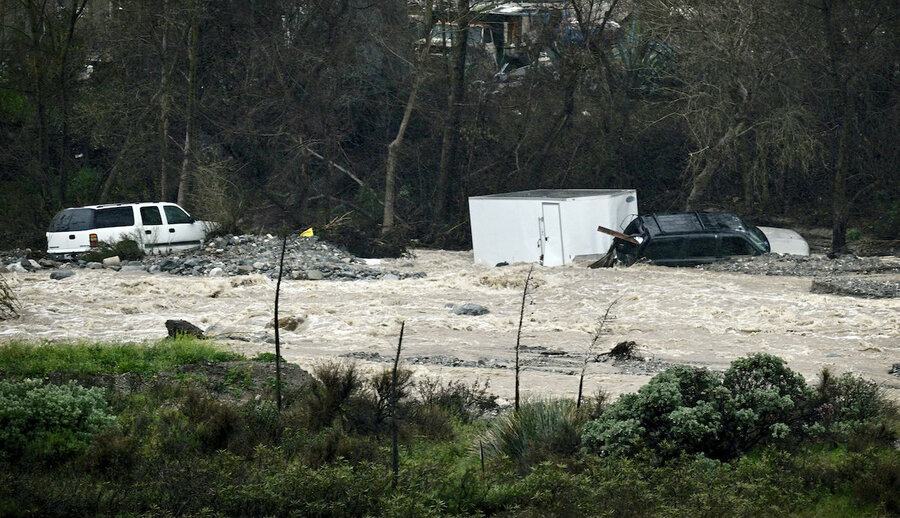Pineapple express? Mudslides? What’s happening in California.
Loading...
| Los Angeles
Rainfall from one of the wettest storms in Southern California history was easing Feb. 6 after Los Angeles was bombarded with nearly half of its seasonal rainfall in just two days, but forecasters warned of a continuing threat for potentially deadly landslides on super-soaked ground. The storm that pummeled California this week was fueled by an atmospheric river, a plume of moisture that extended across the Pacific to near Hawaii.
Downtown Los Angeles received nearly 7 inches of rain by the night of Feb. 5, nearly half the yearly average of 14.25 inches. It was already the third-wettest two-day period since 1877, the National Weather Service said.
In the Los Angeles area, an evacuation order remained in place for some residents of a canyon area that was scarred by a 2022 fire. The area was at increased risk of mud and debris flows because the area was burned bare of brush and trees that could hold it back, authorities said.
Authorities warned people to remain on high alert and most of Southern California remained under flood watches. Swollen and fast-moving creeks and rivers “increase the risk for drowning and the need for swift water rescues,” the weather service said.
The Los Angeles Fire Department said 1,000 firefighters had dealt with more than 300 mudslides in addition to more than 100 reports of flooding and rescues of motorists stranded in vehicles on inundated roadways. Shelters added beds for the city’s homeless population of nearly 75,000 people.
The storm plowed through Northern California over the weekend, killing three people who were crushed by falling trees, then lingered over the south. It was the second storm fueled by an atmospheric river to hit the state over the span of days.
What is an atmospheric river?
Atmospheric rivers are long and relatively narrow bands of water vapor that form over an ocean and flow through the sky, transporting much of the moisture from the tropics to northern latitudes.
They occur globally but are especially significant on the West Coast of the United States, where they create 30% to 50% of annual precipitation and are vital to water supplies but also can cause storms that produce flooding and mudslides, according to the National Oceanic and Atmospheric Administration.
Formed by winds associated with cyclones, atmospheric rivers typically range from 250 miles to 375 miles in width and move under the influence of other weather.
Many atmospheric river events are weak. But the powerful ones can transport extraordinary amounts of moisture. Studies have shown that they can carry seven to 15 times the average amount of water discharged daily by the Mississippi River, according to the U.S. Geological Survey.
Forty-six atmospheric rivers made landfall on the U.S. West Coast during water year 2023, according to the Scripps Institution of Oceanography’s Center for Western Weather and Water Extremes. Nine were categorized as strong, two were extreme, and one was exceptional. California experienced extensive flooding and massive snowfall.
A strong atmospheric river in the tropical Pacific near Hawaii has earned the nickname, "the pineapple express."
What happens when an atmospheric river reaches land?
When the moisture-laden air moves over mountain ranges such as the Sierra Nevada along the California-Nevada line, the water vapor rises and cools, becoming heavy precipitation that falls as rain or snow, according to NOAA.
While traditional cold winter storms out of the north Pacific build the Sierra snowpack, atmospheric rivers tend to be warm. Snow may still fall at the highest elevations but rain usually falls on the snowpack at lower elevations. That can quickly prompt melting, runoff, and flooding and decrease the snowpack needed for California’s water supply.
Gov. Gavin Newsom declared a state of emergency for most of coastal Southern California and on Monday, President Joe Biden promised to provide any needed federal help.
“We’ll get any help on the way as soon as you guys request it,” he told Los Angeles Mayor Karen Bass in a telephone call.
This story was reported by The Associated Press.







